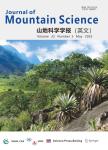版权所有:内蒙古大学图书馆 技术提供:维普资讯• 智图
内蒙古自治区呼和浩特市赛罕区大学西街235号 邮编: 010021

作者机构:Faculty of Civil Engineering and MechanicsKunming University of Science and TechnologyKunming 650500China
出 版 物:《Journal of Mountain Science》 (山地科学学报(英文))
年 卷 期:2025年第22卷第1期
页 面:31-47页
核心收录:
学科分类:08[工学] 0837[工学-安全科学与工程]
基 金:supported by the National Natural Science Foundation of China(41931294) the National Natural Science Foundation of China-Yunnan Joint Fund(U1502232,U1033601)
主 题:Debris flow Fine debris Mineralogy Clay mineral Non-clay mineral
摘 要:Fine debris is an important component of natural debris *** studies focused primarily on the clay minerals found in the fines,and non-clay minerals were often *** effects of mineralogy of fines on debris-mass slurrying and flow behaviors of the resultant slurries are examined *** fines(≤0.04 mm)in the5 mm fraction of the Dongyuege Creek debris-flow deposit is replaced with five other mineral powders with the same maximum particle *** types of separate and sequential experiments related to debris slurrying and slurry behaviors are carried out with the prepared clastic *** obtained slurrying index ranging from 0.08 to 0.18 shows that non-clay minerals also can function as the fine fractions of debris-flow materials,so long as the requirement of grain size distribution is ***,non-clay minerals making up fines of debris flows can increase the upper solid concentration limits of slurrying(with a maximum of 0.692)and peak values of relative excess water pressure(measured maximum mean peak value is 0.99),leading to higher momentum and higher competence,and thereby more destructive *** sediments with platy non-clay mineral-dominated fines have potential for mobilizing into small-to medium-size debris flows with a relatively small *** minerals in the fines may indeed enhance the liquefaction potential of debris masses by expanding the difference between upper and lower solid concentration limits of slurrying(0.413 and 0.238,respectively,for pure kaolinite),but they significantly suppress the momentum,competence,and destructive power of potential debris flows by lowering upper solid concentration limit of slurrying of debris *** catchments rich in non-clay minerals,notably those releasing dolomite into loose sediments,may be more prone to threatening and destructive debris *** basin producing clay minerals should be more susceptible to lowmagnitude/high-frequency debris flows